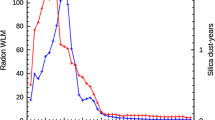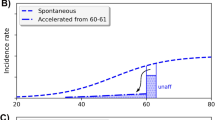Abstract
The biologically based two-stage clonal expansion (TSCE) model is used to analyze lung cancer in several miners studies, two new ones (Czech, French) and two historic ones (Chinese, Colorado). In all cases, the model assumptions are identical. An action of radiation on initiation, promotion, and transformation is allowed. While all four studies indicate a highly significant action of radiation on promotion, the action on initiation is not significant in the French cohort, and barely significant in the Colorado miners cohort. No action on transformation is found in the Colorado miners, while the other data sets indicate a borderline significance. The model can describe all the data sets adequately, with different model parameters. The observed patterns in exposure, time since beginning of exposure, birth year, age and calendar year are reproduced well. The doubling exposure rate for initiation is about 3.5 WLM/year in the new data sets, while it is higher in the historic data sets. For transformation the doubling rate is about 20 WLM/year for the new data sets, while again the historic data give higher estimates. The action of radiation on promotion is quite different in the four data sets. These differences also induce different risk estimates at low exposures. The larger power of the new studies at these low exposures, compared to the historic data requires less extrapolation when the risk at very low exposures is estimated.








Similar content being viewed by others
Notes
WLM (working level month): unit of exposure multiplying a concentration of radon decay products by the duration of exposure. An exposure of 1 WLM is defined as 170 h in an atmosphere of 1 WL where 1 WL is equivalent to any combination of radon decay products in 1 l of air that results in the emission of 130,000 MeV of energy of α-particles.
In terms of the spontaneous biological parameters \(q = \frac{1} {2}{\left( { - \gamma + {\sqrt {\gamma ^{2} + 4\alpha \mu } }} \right)}\) [19].
References
Knudson AG (1971) Mutation and cancer: statistical study of retinoblastoma. Proc Natl Acad Sci USA 68:820–823
Luebeck EG, Curtis SB, Cross FT, Moolgavkar SH (1996) Two-stage model of radon-induced malignant lung tumors in rats: effects of cell killing. Radiat Res 145:163–173
Heidenreich WF, Jacob P, Paretzke HG, Cross FT, Dagle GE (1999) Two-step model for the risk of fatal and incidental lung tumors in rats exposed to radon. Radiat Res 151:209–217
Moolgavkar SH, Luebeck G, Krewski D, Zielinski JM (1993) Radon, cigarette smoke, and lung cancer: a re-analysis of the Colorado Plateau uranium miners’ data. Epidemiology 4:204–217
Luebeck EG, Heidenreich WF, Hazelton WD, Paretzke HG, Moolgavkar SH (1999) Biologically-based analysis of the data for the Colorado uranium miners cohort: age, dose and dose-rate effects. Radiat Res 152:339–351
Hazelton WD, Luebeck EG, Heidenreich WF, Moolgavkar SH (2001) Analysis of a historical cohort of Chinese tin miners with arsenic, radon, cigarette smoke, and pipe smoke exposures using the biologically based two-stage clonal expansion model. Radiat Res 156:78–94
BEIR (1999) Committee on Biological Effects of Ionizing Radiation (BEIR) VI Report, Committee on Health Risks of Exposure to Radon, Health Effects of Exposure to Radon. National Academy Press, Washington DC
Ševc J, Tomášek L, Kunz E, Plaček V, Chmelevsky D, Barclay D, Kellerer AM (1993) A survey of the Czechoslovak follow-up of lung cancer mortality in uranium miners. Health Phys 64:335–369
Tomášek L, Darby SC, Fearn T, Swerdlov AJ, Plaček V, Kunz E (1994) Patterns of lung cancer mortality among uranium miners in West Bohemia with varying rates of exposure to radon and its progeny. Radiat Res 137:251–261
Tomášek L, Plaček V (1999) Radon exposure and lung cancer risk: Czech cohort study. Radiat Res 152 [6 Suppl]: S59–63
Tomášek L (2002) Czech miner studies of lung cancer risk from radon. J Radiol Prot 22:A107–112
Rogel A, Laurier D, Tirmarche M, Quesne B (2002) Lung cancer risk in the French cohort of uranium miners. J Radiol Prot 22:A101–106
Tirmarche M, Raphalen A, Allin F, Chameaud J, Bredon P (1993) Mortality of a cohort of French uranium miners exposed to relatively low radon concentrations. Br J Cancer 67:1090–1097
Laurier D, Tirmarche M, Mitton N et al. (2004) An update of cancer mortality among the French cohort of uranium miners: extended follow-up and new source of data for causes of death. Eur J Epidemiol 19:139–146
Tirmarche M, Bergot D, Billon S et al. (2003) Quantification of lung cancer risk after low radon exposure and low exposure rate: synthesis from epidemiological and experimental data. Final Technical report, February 2000–July 2003. Contract FIGH-CT1999–0013, European Commission DG XII, Brussels, Belgium
Moolgavkar SH (1991) Carcinogenesis models: an overview. In: Glass WA, Varma MN (eds) Physical and chemical mechanisms in molecular radiation biology. Plenum Press, New York, pp 387–395
Heidenreich WF, Paretzke HG (2001) The two-stage clonal expansion model as an example of a biologically based model of radiation-induced cancer. Radiat Res 156:678–681
Heidenreich WF (1996) On the parameters of the clonal expansion model. Radiat Environ Biophys 35:127–129
Heidenreich WF, Luebeck EG, Moolgavkar SH (1997) Some properties of the hazard function of the two-mutation clonal expansion model. Risk Anal 17:391–399
Belli M, Goodhead DT, Ianzini F, Simone G, Tabocchini MA (1992) Direct comparison of biological effectiveness of protons and alpha-particles of the same LET. II. Mutation induction at the HPRT locus in V79 cells. Int J Radiat Biol 61:625–629
Taya A, Morgan A, Baker ST, Humphreys JA, Bisson M, Collier CG (1994) Changes in the rat lung after exposure to radon and its progeny: effects of incorporation of bromodeoxyuridine in epithelial cells and on the incidence of nuclear aberrations in alveolar macrophages. Radiat Res 139:170–177
James F (1994) Minuit function minimization and error analysis, version 94.1. CERN, Geneva
Geddes DM (1979) The natural history of lung cancer: a review based on rates of tumour growth. Br J Dis Chest 73:1–17
Brugmans MJ, Rispens SM, Bijwaard H, Laurier D, Rogel A, Tomášek L, Tirmarche M (2004) Radon-induced lung cancer in French and Czech miner cohorts described with a two-mutation cancer model. Radiat Environ Biophys 43:153–163
Adamson IYR (1985) Cellular kinetics of the lung. In: Witchi HP, Brain JP (eds) Toxicology of inhaled materials. Springer, Berlin, pp 289–317
Heidenreich WF, Hoogenveen R (2001) Limits of applicability for the deterministic approximation of the two-step clonal expansion model. Risk Anal 21:103–105
Heidenreich WF, Wellmann J, Jacob P, Wichmann HE (2002) Mechanistic modelling in large case-control studies of lung cancer risk from smoking. Stat Med 21:3055–3070
Heidenreich WF (2002) Signals for a promoting action of radiation in cancer incidence data. J Radiol Prot 22:A71–74
Kaiser JC, Heidenreich WF, Monchaux G, Morlier JP, Collier CG (2004) Lung tumour risk in radon-exposed rats from different experiments: comparative analysis with biologically based models. Radiat Environ Biophys 43:189–201
Kaiser JC, Heidenreich WF (2004) Comparing regression methods for the two-stage clonal expansion model of carcinogenesis. Stat Med 23:3333–3350
Preston DL, Lubin JH, Pierce DA (1993) Epicure user’s guide. HiroSoft International Corp., Seattle
Acknowledgements
The authors wish to thank J.C. Kaiser for useful discussions. This work was supported by the EU under contracts number FIGH-CT1999–0013 and FI6R-CT-2003–508842.
Author information
Authors and Affiliations
Corresponding author
Appendix
Appendix
Comparison of individual likelihood and Poisson regression
As was detailed above, in applications of the TSCE model it is customary to use an individual likelihood. The heuristic models favored for statistical analysis [7] can be more easily handled with Poisson regression. Simulations have shown that Poisson regression is not always ideal for estimating parameters in mechanistic models [30]. Therefore, a comparison of the two estimation procedures, individual likelihood and Poisson-likelihood, was performed using the French miners data. Two different software packages were used for estimating the parameters, MINUIT [22] for the individual likelihood and EPICURE (AMFIT sub-package) [31] for Poisson-regression. The resulting deviances are given in Table 9. It can be seen that the differences in deviance between the two models considered are very similar in the two statistical techniques. The estimated parameters and their estimated errors and confidence bounds agreed between the two techniques. Therefore we are confident that improvements in the deviance by refinements of the heuristic models (done with AMFIT) can be compared with improvements calculated with the individual likelihood.
Rights and permissions
About this article
Cite this article
Heidenreich, W.F., Tomášek, L., Rogel, A. et al. Studies of radon-exposed miner cohorts using a biologically based model: comparison of current Czech and French data with historic data from China and Colorado. Radiat Environ Biophys 43, 247–256 (2004). https://doi.org/10.1007/s00411-004-0266-3
Received:
Accepted:
Published:
Issue Date:
DOI: https://doi.org/10.1007/s00411-004-0266-3




